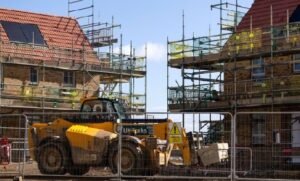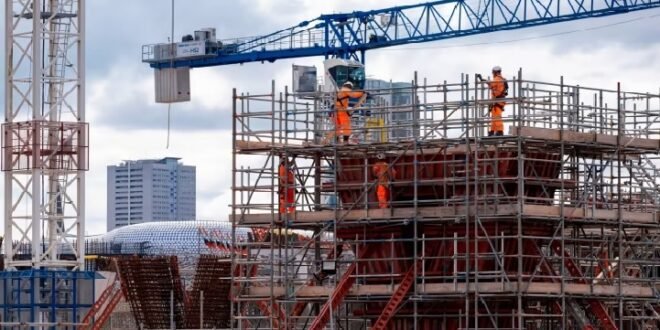08-08-2025
LONDON: Activity in Britain’s construction sector fell by the most in more than five years last month, according to a survey that raises questions about whether the government will achieve its target of building 1.5 million homes by mid-2029.
S&P Global’s monthly purchasing managers’ index for the construction sector fell to 44.3 in July from 48.8 in June, it’s lowest since May 2020 and below all forecasts in a media poll of economists.
 “Dissecting the latest contraction, we can see a fresh and sharp drop in residential building, as well as an accelerated fall in work carried out on civil engineering projects,” Joe Hayes, principal economist at S&P Global Market Intelligence, said.
“Dissecting the latest contraction, we can see a fresh and sharp drop in residential building, as well as an accelerated fall in work carried out on civil engineering projects,” Joe Hayes, principal economist at S&P Global Market Intelligence, said.
Britain’s government has pledged planning reforms to enable the construction of 1.5 million homes before the next election due by mid-2029, which will require a pace of construction last achieved in 1970.
Finance minister Rachel Reeves also loosened budget rules last year to allow more borrowing for public infrastructure investment.
However, building firms in the S&P survey reported site delays, a lack of tender opportunities and a reluctance from customers to commit to contracts. The pace of decline was smallest for commercial work such as shops and offices and greatest for civil engineering.
Staff numbers fell for a seventh month in a row while new orders dropped at the second-fastest pace since 2020.
The downbeat picture contrasts with slightly more upbeat past official data, which showed construction output grew by 1.2% in the three months to the end of May, including a 0.9% increase in new work and a 1.5% rise in repair and maintenance.
However, analysts warn that the building trade is struggling with crippling labour shortages and other mounting economic headwinds that could stifle investment in housebuilding, including stubborn inflationary pressures and tax rises such as April’s jump in employers’ national insurance contributions (NICs).
 Matt Swannell, the chief economic adviser to the EY Item Club, said: “Businesses will continue to face a difficult operating environment as labour costs remain high due to ongoing labour shortages, as well as higher NICs and national living wage.
Matt Swannell, the chief economic adviser to the EY Item Club, said: “Businesses will continue to face a difficult operating environment as labour costs remain high due to ongoing labour shortages, as well as higher NICs and national living wage.
“The outlook for housebuilding in particular is mixed as the effects of planning reforms are counter-balanced by elevated construction costs and labour market shortages.” There is mounting speculation about tax rises in Rachel Reeves’ autumn budget, despite business groups warning that further increases could hit the chancellor’s ambition to drive up economic growth.
On Wednesday the National Institute of Economic and Social Research said the chancellor could be facing a shortfall in the public finances worth up to £50bn at the autumn budget.
However, ministers are hopeful that Britain’s economy could turn a corner, with support from further Bank of England rate cuts easing some of the financial pressure on households and businesses. Financial markets anticipate at least two further reductions in borrowing costs by December 2026, taking the base rate to 3.5%.
Elliott Jordan-Doak, a senior UK economist at the consultancy Pantheon Macroeconomics, said: “We still think the fundamentals point to sentiment in the construction sector gradually improving in the coming months.
“The Bank of England will likely cut interest rates in August, reducing borrowing costs for businesses, and the shock from tariff uncertainty will continue to fade. Moreover, the government’s focus on investment spending and planning reforms should also provide support to the construction industry. The PMI should recover over the coming months.” (Int’l News Desk)
 Pressmediaofindia
Pressmediaofindia




